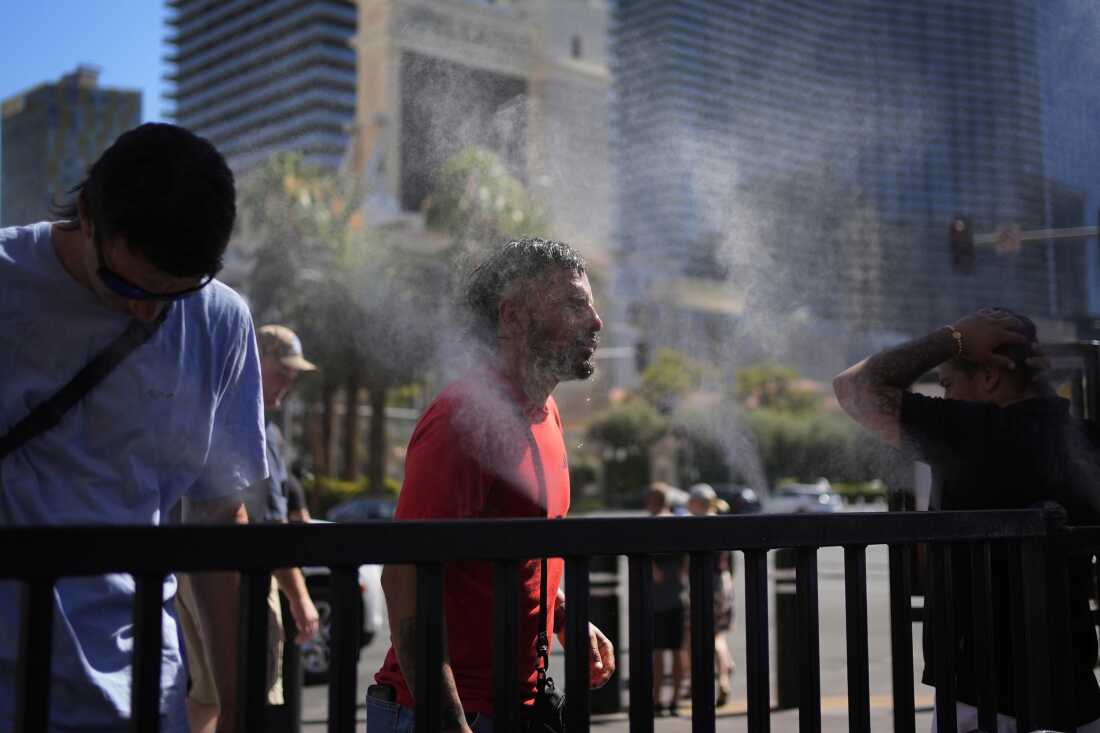Environmental activists rally in front of the U.S. Supreme Court in 2022 after it ruled against the Obama administration’s plan to cut climate-warming emissions at the nation’s power plants. The Supreme Court has since further limited the power of federal agencies like the Environmental Protection Agency.
Drew Angerer/Getty Images
hide caption
toggle caption
Drew Angerer/Getty Images
Nerdy question for all of you policy wonks out there: What did the Obama administration’s landmark climate regulation on the nation’s power plants — the Clean Power Plan — and the Trump administration’s more lenient replacement of it — the Affordable Clean Energy Rule — have in common?
Both were seen as major industry-changing regulations. Both were lauded by some and reviled by others.
And neither went into effect.
“Basically any environmental rule of any magnitude is challenged in the courts,” said Lisa Heinzerling, a law professor at Georgetown University and a senior adviser to former President Barack Obama’s Environmental Protection Agency (EPA). “The courts have the final word.”
As President Biden and former President Donald Trump vie for a second term amid what’s sure to be one of the hottest years in recorded history, NPR’s Climate Desk has looked at both candidates’ records on climate change and what to expect if either is elected. Trump is promising to “drill, baby, drill,” and weaken regulations on oil and gas development. Biden is promising to create more jobs with an energy transition away from climate-warming fossil fuels.
But given the litigious nature of environmental law and the U.S. Supreme Court’s recent decisions, particularly one limiting the power of federal agencies, legal experts say one of the election’s most consequential aspects for the climate would be the judicial appointments either candidate makes.
The president has the power to nominate federal judges for lifelong terms. Not only to the Supreme Court, but also to federal appellate and district courts, which see tens of thousands of cases each year. Pending Senate approval, those appointments shape the country’s judiciary and the government’s ability to implement laws for decades.
People cool off in misters along the Las Vegas Strip during a deadly, record-breaking heatwave. Heatwaves are growing in intensity, frequency and duration as climate change intensifies.
John Locher/AP
hide caption
toggle caption
John Locher/AP
“Almost all cases involving some type of environmental action ultimately go to a court of appeals,” said Jeff Holmstead, an attorney with the law firm Bracewell LLC, who worked on air issues at the EPA under former President George W. Bush.
Biden has appointed 201 judges, including one justice to the Supreme Court. Trump appointed 234, including three Supreme Court justices, giving conservatives a 6-3 majority on the nation’s highest court.
Since then, the Supreme Court has ruled against agencies’ ability to cut climate-warming emissions, to protect the nation’s wetlands and ephemeral streams and to limit air pollution for states downwind of power plants and factories.
“I think it is clearer than ever that folks who believe fervently that we should protect public health from environmental harms really can’t make progress if they have a hostile judiciary waiting,” said Cara Horowitz, executive director of the Emmett Institute on Climate Change and the Environment at the UCLA School of Law. “The work becomes a lot harder when you have a Supreme Court sitting at the end of every litigation road that’s hostile to the administrative state and environmental regulations.”
Recent SCOTUS decision could greatly affect climate regulation
For the last 40 years, the American judicial system has operated with the understanding that if a law is ambiguous, the courts should defer to the expertise of the federal agency implementing it, as long as that implementation is reasonable.
In other words, if a law like the Clean Air Act isn’t crystal clear, the courts would defer to experts and scientists at federal agencies, like the EPA, to fill in the gaps when writing regulation and implementing laws.
In its recent term, the Supreme Court’s conservative majority threw out what’s known as the Chevron deference in a ruling on two related cases. Writing for the majority, Chief Justice John Roberts argued that “courts must exercise their independent judgment in deciding whether an agency has acted within its statutory authority.”
Legal experts say the decision could affect the government’s ability to regulate food, medicine, telecommunication and worker safety, among others. But the implications for environmental regulations are particularly stark. That’s because the Clean Air Act, the Clean Water Act and the Endangered Species Act were purposely written vaguely to accommodate for future problems.
“Many of these laws were passed in the 1970s when we were gaining an understanding of various environmental issues, and when Congress wrote these laws, they imparted on agencies a very capacious authority to account for the best available science,” said Erik Schlenker-Goodrich, executive director of the Western Environmental Law Center. “And the best available science emerges over time.”
The Endangered Species Act, which protects imperiled plants and animals like the Key Deer, is more than 50 years old. Federal agencies are tasked with using old environmental statutes to deal with modern problems, fueling much of the environmental litigation seen in federal courts.
Ryan Kellman/NPR
hide caption
toggle caption
Ryan Kellman/NPR
Scientists’ understanding of emerging environmental problems like climate change, PFAS and plastic pollution is constantly evolving. Government agencies are tasked with protecting people from those problems using existing laws.
“So when Supreme Court justices are saying we’re going to freeze things as we knew them back in the 1970s, what they’re essentially saying is agencies can’t account for the science, agencies can’t adapt to the science and agencies cannot protect the public’s interest,” Schlenker-Goodrich said.
Proponents of the Supreme Court’s decision argue the Chevron deference gave federal agencies too much power.
“The fact that a statute was silent on an issue doesn’t mean that Congress intended to let the agency sort of read it however it wants,” Holmstead said.
Agency attorneys “are acting like anybody else’s attorneys,” said Damien Schiff, a senior attorney focused on environmental law at the Pacific Legal Foundation, a conservative public interest law group. “They’re just simply advocates articulating a view, but it’s not necessarily privileged in terms of its accuracy or propriety just because it’s being articulated by a government agency.”
Schiff, whose law firm filed an amicus brief calling for the end of Chevron, said the change is part of a broader shift in the court’s approach to law that could help groups on the left and those on the right, making it easier “for private parties to try to vindicate their rights against government entities.”
JJ Apodaca, executive director of the Amphibian and Reptile Conservancy, said the shift means instead of relying on federal scientists, “with Ph.D.s and master degrees,” decisions will now be made by judges who, “have political affiliations and in many cases, haven’t taken a science or biology class since high school.”
The Obama and Biden administration’s have tried using the Clean Air Act to limit climate-warming emissions from the nation’s power plants, but their efforts have been held up or blocked in courts.
J. David Ake/AP
hide caption
toggle caption
J. David Ake/AP
The politics of the judiciary
An impartial judiciary has been a cornerstone of American democracy since its inception.
Trump’s term led to the most conservative Supreme Court in more than 90 years, but it also allowed Republican leadership to place more than 230 other judges in federal district and appellate courts — which issue “the bulk of the federal legal decisions in this country,” Heinzerling said.
Earlier this year, a federal appeals court ended a long-running lawsuit by young plaintiffs in Oregon who argued the U.S. government’s contribution to climate change violated their constitutional rights. In 2022, a U.S. district court restored endangered species protections to gray wolves in 44 states.
Those lower courts often get the benefit of the doubt, Heinzerling said. “Which means they can have a huge influence on what the regulatory landscape looks like.”
In his first campaign, Trump vowed to appoint judges in the mold of the late conservative Justice Antonin Scalia. Three-quarters of his appointees were men and roughly 84% were white, according to the Pew Research Center. An analysis by The Washington Post in May found that Biden has placed more non-white federal judges than any president in history. Nearly two-thirds are women.
“When he talks about rights and liberties, [Biden] knows that in the end those rights and liberties are decided by federal judges, so the makeup of the federal judiciary is connected to everything else we do,” former White House chief of staff Ron Klain told NPR last year.
Biden has had less say on the makeup of the Supreme Court, filling only one opening during his first term — Justice Ketanji Brown Jackson — and legal experts say it’s unlikely he’d be able to shift it in a second term. The court’s two oldest justices, Clarence Thomas and Samuel Alito, are both conservative and unlikely to retire if Biden is reelected. If Trump wins in November, critics fear he could replace both with younger justices, locking in the court’s conservative majority for decades to come.
Regardless of who wins, legal experts say, the Supreme Court’s recent decisions will make it harder for the federal government to tackle environmental problems like climate change, barring new legislation from Congress.
“[Chevron] makes it harder for agencies to use old laws to address new problems,” said Sam Sankar, senior vice president for programs at the environmental firm Earthjustice. “But that doesn’t mean that we can’t address the threats of climate, and we will. Problems are getting bad enough that Congress, even the right wing, is going to start needing to react to these things in federal lawmaking.”
“The question is,” he added, “how much do we lose and how much does it cost us to try to address the problems we’ve got?”











































